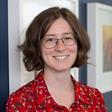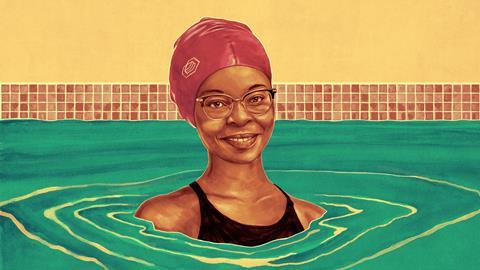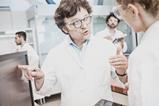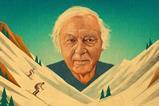The interdisciplinary innovator on moving beyond silos and communicating the real-world impact of chemistry
Wunmi Sadik is a distinguished professor and chair in the Department of Chemistry and Environmental Science at the New Jersey Institutes of Technology (NJIT). She is also the director of the NJIT BioSMART Center. Sadik is internationally known for her creativity in developing innovative biosensors for different applications – from environmental monitoring, to early cancer detection and objective pain assessment. She is a leading expert in point-of-care (POC) biomedical devices, nanomaterials, and sustainable and green technologies. She was the inaugural chair of the Gordon Conference on Environmental Nanotechnology and co-founded the Sustainable Nanotechnology Organization (SNO).
I come from a family that really encouraged me to enter into the sciences. My dad was very, very encouraging. My older brother was my first contact with chemistry. He would come home from school and tell me about Boyle’s law and Charles’ law. I would look at his textbooks and just start to read, fascinated. I also remember my first chemistry teacher, in form three (age 12–13). He showed us all different apparatuses, and I was captivated.
When I decided on chemistry as a major at university, I had never met a practicing chemist. I simply enjoyed chemistry, and I found that it challenged me in a very positive way.
It was a challenge to convince my mother that chemistry was worth studying at university. She did not understand the concept of chemistry. With my own minimal knowledge of chemistry at the time, I struggled to explain what chemistry was all about. Nigeria is a petroleum-exporting country, so I started by explaining where the kerosene she used to cook came from and progressed from there. Her conclusion: ‘if anybody is willing to pay you to work as a chemist, then it’s probably worth doing.’
I like to think about my work in terms of innovation and problem solving. What can we do differently? How can we use what is already known to solve another problem? My philosophy is to explain how chemistry permeates the world around us, how it is not confined to a lab or a refinery, and that it offers solutions that don’t just come in flasks. I do a lot of work with engineers using computer simulations. I like to look at how to take our research beyond the mathematical/computational simulation to real-life solutions. It goes back to how I tried to explain things to my mother all those years ago.
Ideas exist in silos, despite our best efforts. Departments are structured based on independent fields of study. However, this organisational structure inadequately describes many areas of study. This has slowly started to improve. Traditionally, chemistry has been categorised into analytical, physical, organic, and inorganic chemistry. In the last few years, the United States National Science Foundation (NSF) has restructured the division of chemistry into interdisciplinary areas. There is an emphasis on transdisciplinary and translational science and technology geared more toward the application or even the interdisciplinary branches, such as environmental chemical sciences and sustainability.
I am a collaborative leader. I have a passion for what I do. I get energy from my students and my postdoctoral fellows. I always try to assign them to projects that they are passionate about because I know that’s when they will be at their very best.
Science accelerates when it is shared
My proudest achievement is how I have been able to impact the next generation of scientists. My students and mentees, starting from the high school level to college and PhDs, are my inspiration. I also gain motivation from how my work and my career have been able to impact people’s lives. It drives me to continue.
My best career advice is to find an area where you can define questions and where you can make an impact. Choose questions at the frontiers of current thought. Be a curious and unfettered thinker. Never be afraid to make tough choices and challenge conventional thinking. Look at your challenges as opportunities. Be persistent, practical, and patient, and see beyond your limitations. Remain humble and content to enjoy your successes and live with your failures. Don’t limit yourself by where society places you or how you are classified. I have always believed as a Nigerian American, if you’re not called to sit at the table, create your own, and look for ways to pay back to the community. Science accelerates when it is shared.
I co-founded an organisation called the Sustainable Nanotechnology Organization (SNO). With the emergence of game-changing technology such as nanotechnology, there are always questions about long-term implications; mainly whether the technology will be safe and sustainable. Key among these concerns is the possibility of unintended consequences emerging from something as powerful as nanotechnology. While these concerns have been raised in several quarters, only a few people have taken actual steps to do something about it. I chaired the inaugural Gordon Research Conference on environmental nanotechnology, leading to the emergence of the SNO.
We had the support of the US EPA and the NSF, encouraging us to advance scientific enterprise and the practice of nanotechnology as a tool for sustainability. We achieved these goals by providing programming to include research, education and innovation in a sustainable manner and supporting researchers and scientists from day one. I see this hard work paying out today. We have yet to see a major catastrophe resulting from nanotechnology, mainly because we have taken a proactive approach from the beginning to research and innovative applications of the field.
I am very excited about the development of biosensors to measure pain. Pain is very subjective and challenging to quantify. I believe pain, at least inflammatory pain, is fundamentally a biochemical issue at the core. If one understands the biochemistry of pain, you can develop monitors to quantitatively measure pain, similar to monitors that give us the level of glucose in the blood.
There’s not a lot of free time in scientific research. I can attest to that because I’m a mother of three adult children and also a wife. My daughter is a Harvard and Johns Hopkins-trained physician. She will be collaborating with me on pain biosensor research. My oldest son is a lawyer (Harvard MBA, Yale JD). We have a younger son who is studying economics and computer science at Washington University in St. Louis. Between them, I am very busy and engaged.
I love to swim and travel the world. I have lived on three continents and travelled quite a bit. I’m very passionate about swimming. I love to do motivational talks, and I am also very active in my local church. I teach weekly Bible studies and lead prayer groups.
I still see myself as the young girl explaining chemistry to my mother. I always think about how I can break the work down so that somebody like my mom will understand what chemistry is. That’s always been my motivation – to take chemistry beyond the classroom, to show that chemistry goes beyond test tubes and reagents.


















No comments yet